Overview
A three-day-a-week workout routine is designed to provide a balanced approach to fitness, incorporating cardiovascular exercises, strength training, and flexibility work, which can lead to significant health benefits such as improved muscle strength and cardiovascular fitness. The article supports this by highlighting research that shows structured training can yield notable strength improvements and enhance overall well-being, making it a practical option for busy individuals looking to maintain their health without overwhelming their schedules.
Introduction
In a world where busy schedules often overshadow personal health, embracing a three-day workout routine presents a powerful solution for individuals seeking to enhance their fitness without overwhelming their lives. This approach not only promotes physical well-being but also integrates seamlessly into the hectic lives of professionals, offering a balanced blend of cardiovascular exercise, strength training, and flexibility work.
With the support of a comprehensive wellness coaching app, individuals can access personalized guidance, nutrition strategies, and a vibrant community, making it easier than ever to stay motivated and committed. Research highlights the significant health benefits of even moderate exercise, suggesting that a structured routine can lead to improved strength, mental well-being, and longevity.
As teams embark on this transformative journey, they not only invest in their fitness but also cultivate a culture of health and resilience within their organizations.
Defining the Three-Day Workout Routine
Embracing a three day a week workout routine opens the door to a balanced and effective health journey, especially when supported by a comprehensive wellness coaching app. This structure, which typically involves a three day a week workout, enables individuals to combine cardiovascular exercises, strength training, and flexibility work in a manner that aligns with their personal wellness levels and objectives. Enhanced by guided nutrition and mindset strategies, this app empowers busy professionals to seamlessly integrate fitness into their demanding schedules.
By committing to a three day a week workout, individuals can achieve significant health benefits while enjoying daily programming and access to a built-in community for motivation. Research indicates that participants in structured training programs can experience noteworthy strength improvements; for instance, Arazi and Asadi reported an impressive pre- vs post-intervention strength difference of 5.0 kg, highlighting the effectiveness of a well-planned exercise regimen. Furthermore, a case study named 'Upper Body Strength Gains with High Frequency Training' discovered that individuals participating in high frequency training achieved significantly greater upper body strength improvements compared to those adhering to a low frequency program.
This evidence supports the notion that even a modest commitment to physical activity can yield substantial rewards. Expert Vegard M Iversen emphasizes that a variety of repetition velocities can be employed to instigate muscular adaptations, affirming that such flexibility in training routines can enhance the benefits of a three-day plan. Furthermore, recent statistics show that the mean effect size for medium frequency training is 0.65, indicating its effectiveness in promoting strength gains.
The app also features habit formation strategies, direct messaging capabilities for personalized support from coaches, and bi-weekly group calls to foster accountability and community engagement. Thus, a three day a week workout not only improves physical fitness but also allows individuals to prioritize their well-being without overwhelming their busy lives, all while receiving personalized support from dedicated coaches through our app.
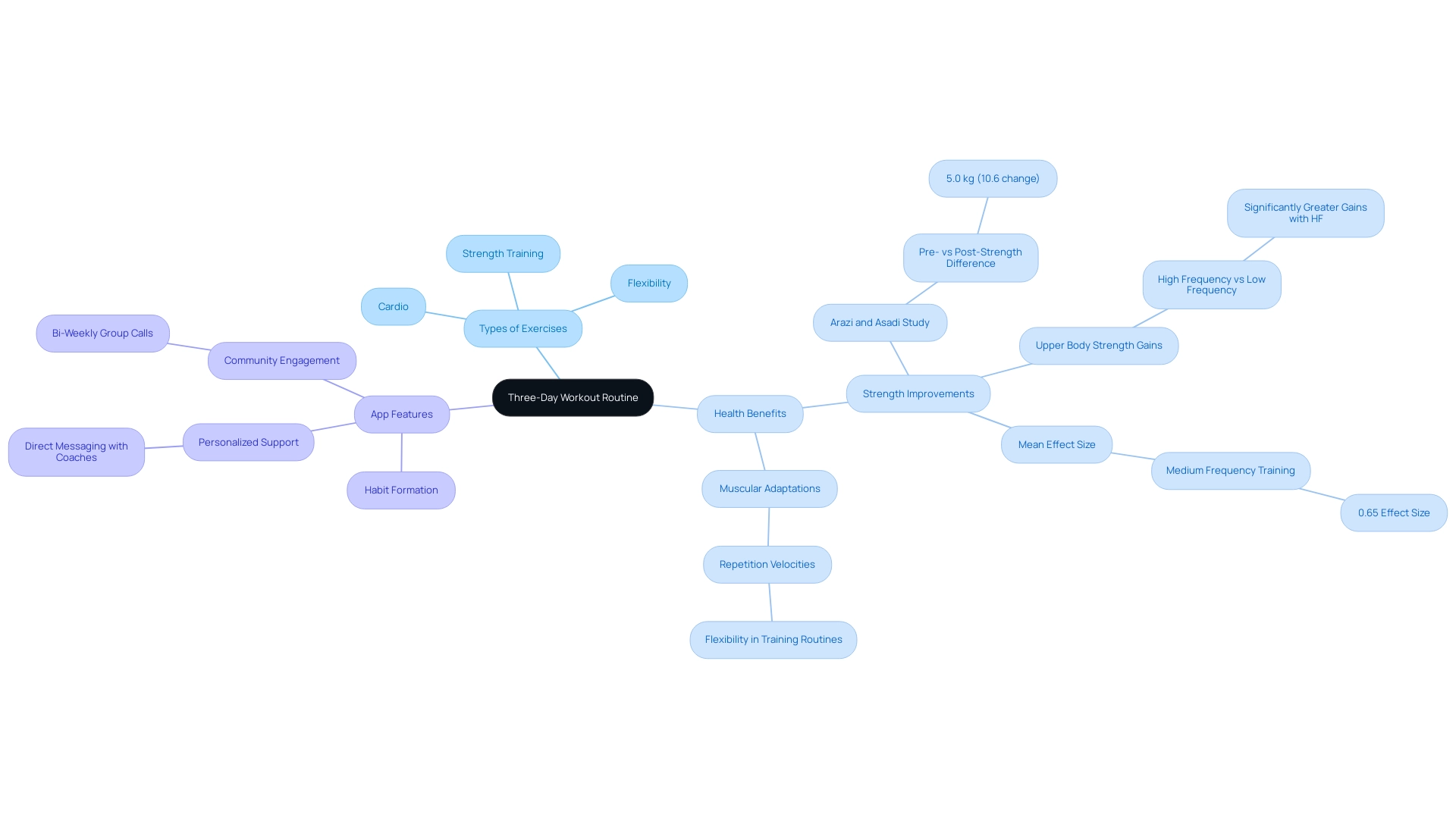
Benefits of Working Out Three Days a Week
Participating in a three day a week workout regimen reveals a wealth of advantages, including enhanced cardiovascular fitness, increased muscle strength, and improved mental well-being. With the personalized coaching and guidance of experienced professionals, teams can make lasting lifestyle changes that empower their overall well-being. Research highlights that even moderate physical activity can lead to significant improvements, such as a reduced risk of chronic diseases and effective stress management.
Notably, regular physical activity can lead to an average increase in life expectancy by 1 to 2 years by the age of 80, emphasizing its vital role in long-term health. This statistic serves as a compelling argument for adopting a three day a week workout regimen. Moreover, this workout schedule allows for essential recovery periods, crucial for muscle repair and growth, ensuring that the body can bounce back stronger after each session.
For those with hectic lives, this practical approach fits seamlessly into daily routines, enabling individuals to maintain a consistent exercise regimen without feeling overwhelmed. As one specialist pointed out, enhancements in measures of well-being can happen due to rising levels of physical activity without alterations in aerobic conditioning. This demonstrates that the commitment to a three day a week workout can initiate profound changes in overall wellness and well-being.
Furthermore, testimonials from participants emphasize their satisfaction:
'Thanks to the personalized coaching, I've not only enhanced my well-being but also gained invaluable knowledge about maintaining a healthy lifestyle.'
Research, including the one centered on an intensive training program for postmenopausal women, demonstrate that structured exercise can significantly combat issues like osteoporosis, showing a marked reduction in the rate of bone loss. These findings reaffirm the necessity of regular activity.
Furthermore, insights from the Youth Risk Behavior Surveillance System highlight the alarming trends in physical inactivity among youth, reinforcing the importance of establishing a culture of health early on. Adopting this attainable wellness approach, backed by customized guidance that provides individuals with vital knowledge and skills for improved living, not only promotes personal well-being but also encourages a culture of wellness within teams. Contact us today to learn how our coaching can help your team thrive and create a lasting impact on their health and wellness journey.
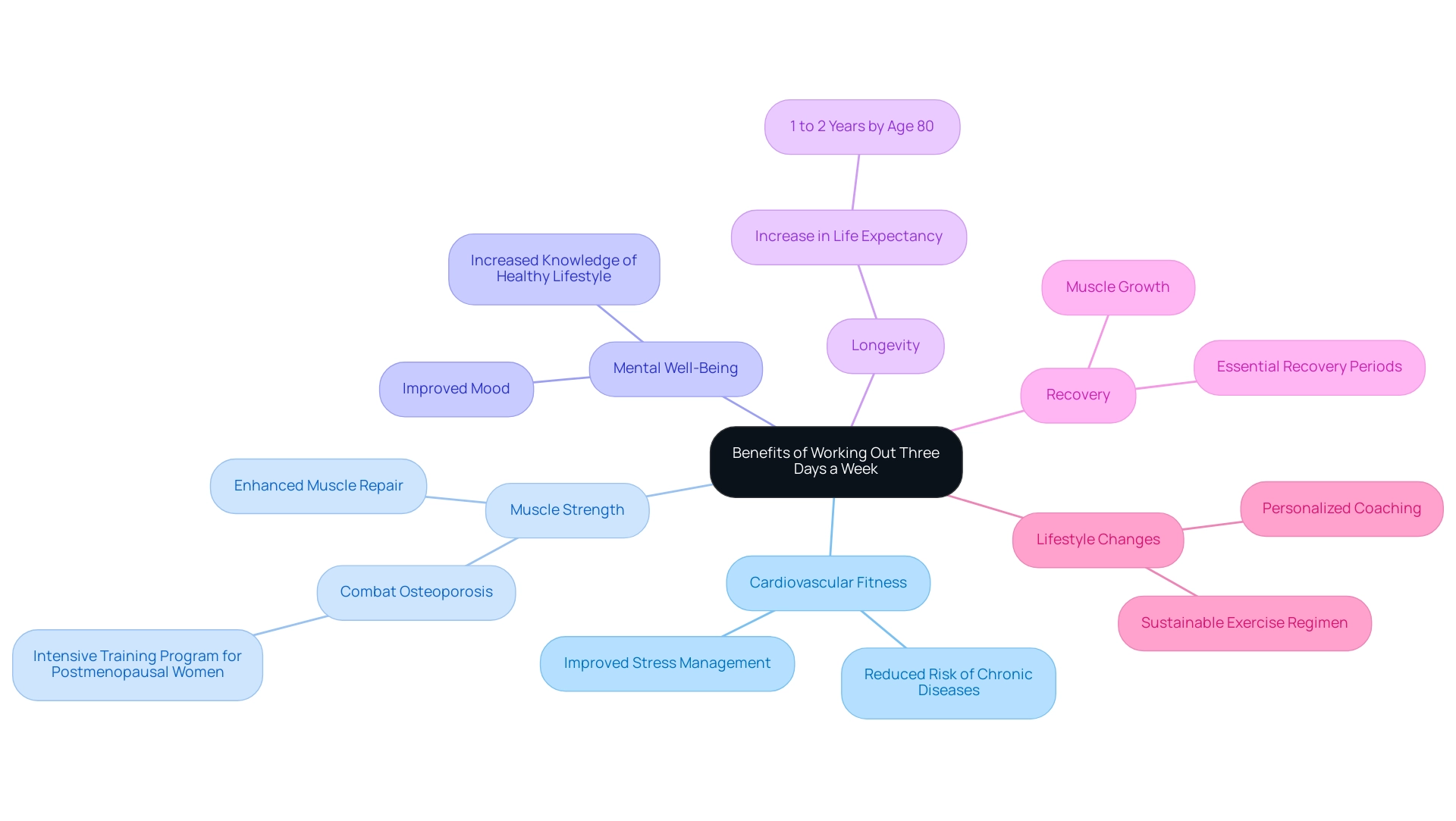
Exploring Workout Structures: Full-Body vs. Split Routines
In a three day a week workout plan, individuals can effectively choose between full-body sessions and split schedules, each providing unique advantages suited to different health objectives. A full-body workout engages all major muscle groups during each session, proving particularly advantageous for those seeking comprehensive fitness gains within a limited timeframe. This approach allows for balanced development and can be incredibly effective for individuals pressed for time.
On the other hand, split schedules concentrate on specific muscle groups each day, facilitating targeted training and potentially enhancing muscle growth. Research indicates that while both methods yield impressive results—such as similar increases in strength, jump height, upper-body power, and muscle mass—split approaches may offer a slight edge in muscle hypertrophy for those focused solely on strength gains. Specifically, a study discovered that individuals participating in split training enhanced their bench press strength by 24.0%, in contrast to a 15.4% rise for full-body exercises.
Furthermore, a case study titled "Eficacia de programas de entrenamiento de resistencia" evaluated a 12-week resistance training program in untrained women and found no differences between full-body and split training groups in any measured variable, with both showing improvements in maximum strength, muscle mass, and jump height. Ultimately, the decision between these two workout structures should align with personal exercise goals, time availability, and recovery needs, particularly when opting for a three day a week workout. For an individual focused on enhancing strength improvements, split routines may be the favored option, while those striving for overall well-being would gain significantly from full-body workouts.
By leveraging Foresight's comprehensive wellness coaching services, including in-person wellness talks, pantry and nutrition services, and white-glove service, HR Benefits Managers can empower their teams to engage in personalized fitness coaching and custom program development through app-based delivery. The app not only facilitates access to tailored coaching resources but also enhances client engagement by connecting them with a supportive community, leading to lasting lifestyle changes and vibrant health.
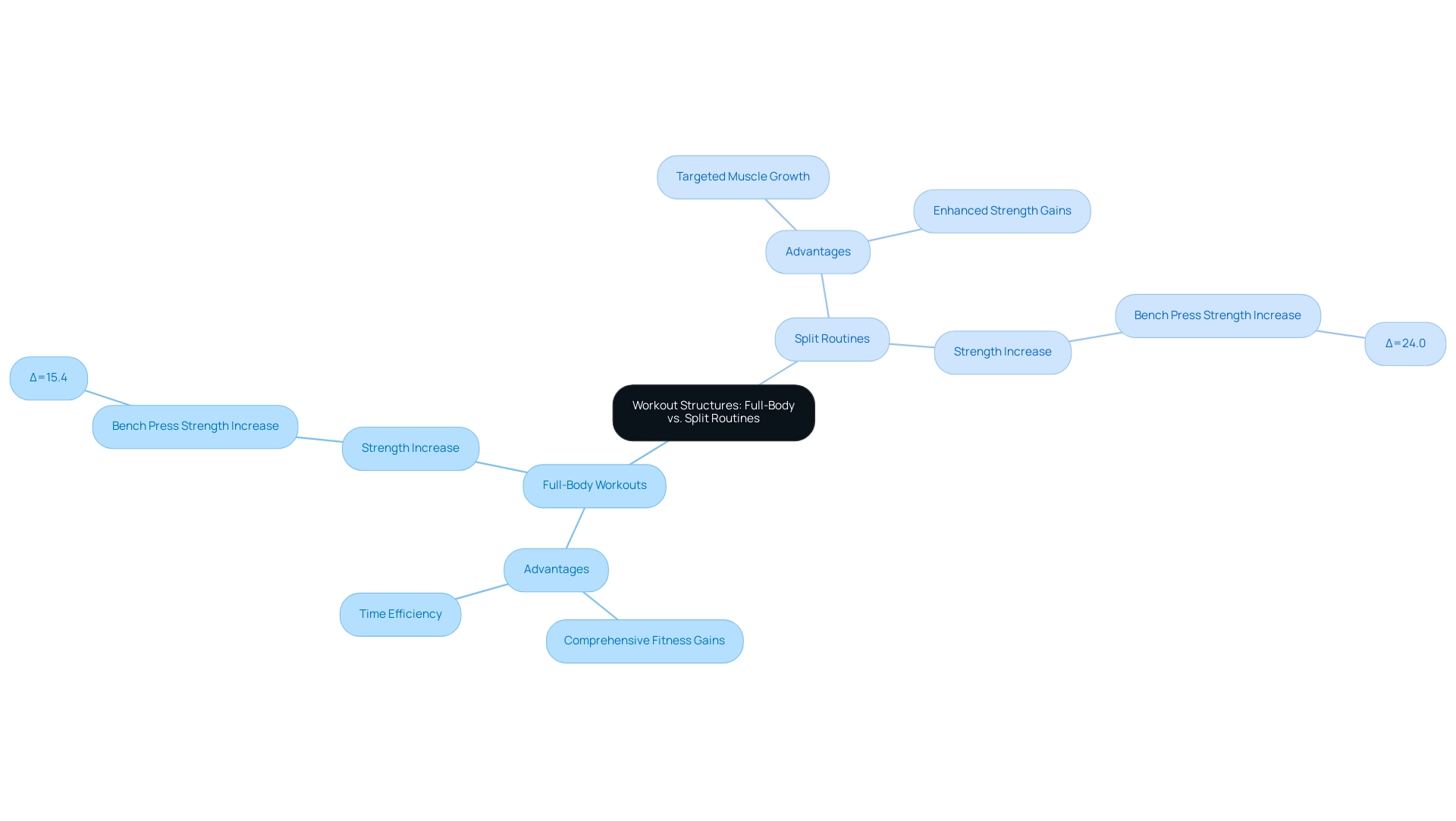
Key Considerations for a Successful Three-Day Workout Plan
Embarking on a three day a week workout plan requires careful consideration of several crucial factors that significantly enhance the effectiveness of the routine. Recovery stands at the forefront; ensuring sufficient rest between exercises is vital to prevent overtraining and injuries. Tailored recovery strategies, such as the frequency of daytime napping, have been shown to vary among athletes, underscoring the importance of personalized wellness approaches.
For instance, a study found that international athletes are more likely to utilize naps effectively compared to national athletes, with racewalkers napping more frequently than middle and long-distance runners. This emphasizes the necessity for personalized recovery techniques tailored to particular employee requirements and wellness levels, a cornerstone of our corporate wellness programs.
Creating a regular exercise routine, like a three day a week workout, is equally vital, as it aids in incorporating physical activity into hectic lifestyles, making it simpler to adhere to the plan. Nutrition plays an indispensable role in achieving health objectives; incorporating healthy eating habits alongside the workout schedule is essential. Nutritionists stress that a synergistic approach to diet and exercise can lead to improved outcomes, reinforcing the belief that what employees consume directly impacts their ability to perform and recover.
Studies indicate that C-reactive protein levels may decline with a structured exercise regimen, suggesting enhanced recovery and overall well-being (SMD = −0.38, 95% CI: −0.59 to −0.14).
Moreover, establishing achievable objectives and diligently monitoring progress can act as powerful motivators on this wellness journey. By maintaining focus and commitment, employees can foster a sense of achievement that fuels their momentum. As wellness specialists highlight, grasping the significance of recovery and nutrition not only improves performance but also fosters a sustainable journey to vitality and well-being.
These wellness initiatives can lead to reduced absenteeism and lower healthcare costs, ultimately benefiting the company's bottom line. As Herbert and Gabriel noted, 'For some time stretching has not been recommended after exercise, as it might even lead to an increase in DOMS.' Therefore, as HR Benefits Managers, encouraging your teams to embrace these principles through tailored wellness programs can significantly contribute to their overall wellness, productivity, and cognitive performance, fostering a thriving workforce.
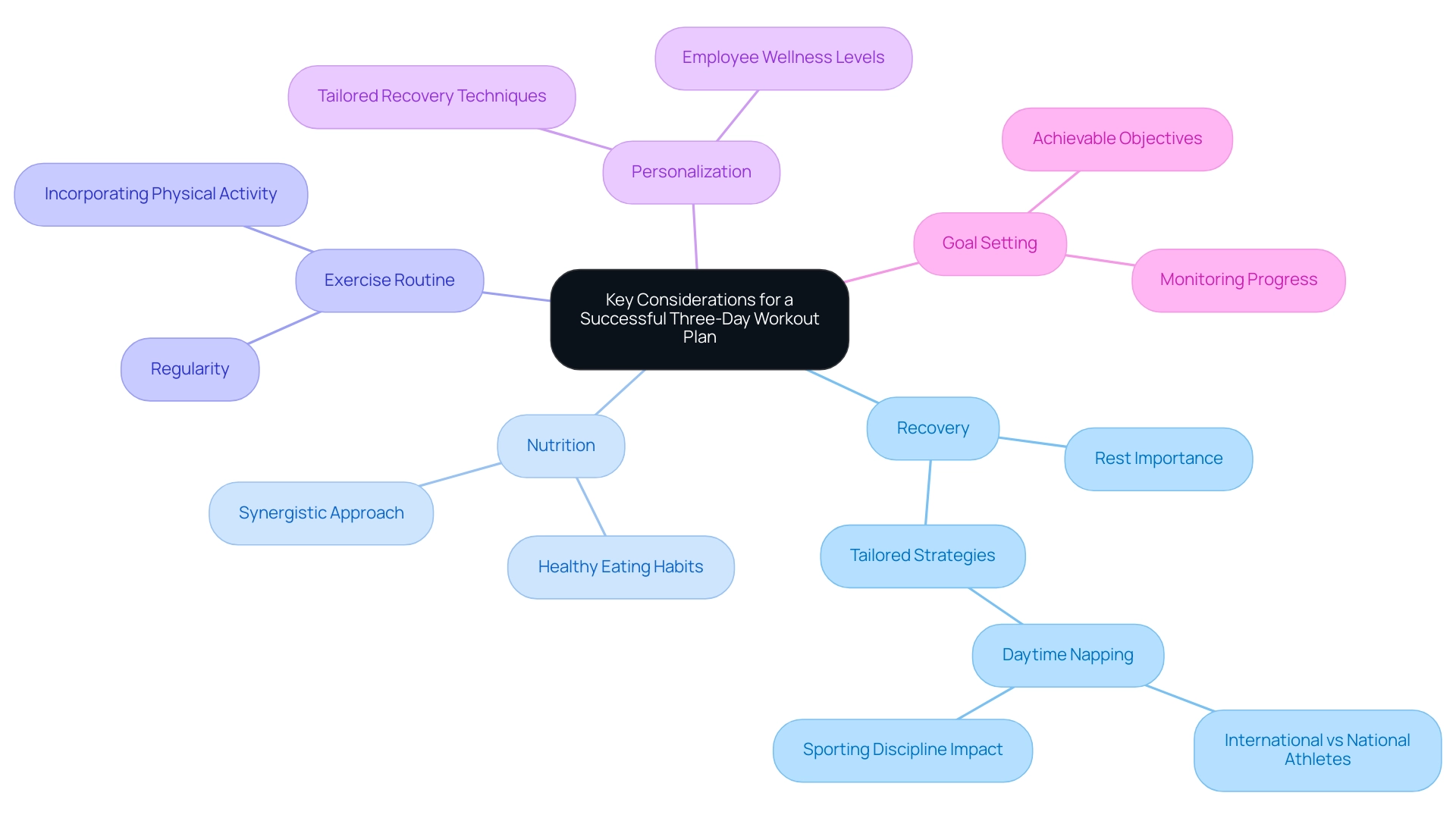
Practical Tips and Sample Routines for Three-Day Workouts
Starting a three day a week workout plan can be transformative for busy people aiming to improve their health and overall job performance. Research shows that regular exercise not only boosts motivation but also improves cognitive abilities and emotional well-being. A study published in the journal 'Preventive Medicine' found that employees who engaged in regular physical activity reported a 20% increase in motivation at work.
Here are some practical tips and sample routines to help you get started:
- Tip 1: Designate specific days for your workouts—consistent days like Monday, Wednesday, and Friday can create a reliable exercise habit, fostering a culture of health within your team.
- Tip 2: Strive for a balanced approach by incorporating both strength training and cardio into each session. This combination maximizes efficiency and enhances overall fitness and well-being, as supported by multiple studies highlighting the positive effects of exercise on workplace engagement and reduced absenteeism. For instance, a workplace exercise program was linked to a 15% decrease in absenteeism.
To tailor your exercise programs, consider categorizing activities into primary, secondary, and isolation groups. Primary exercises, such as squats and deadlifts, serve as compound lifts that form the core of your training, effectively targeting multiple muscle groups. As noted, "Due to the movements involved in these exercises, many of them will also train some of your leg muscles (such as the glutes and hamstrings) while also hitting your rear delts."
Sample Routine:
- Day 1: Begin with a full-body strength session, focusing on primary exercises like squats, push-ups, and lunges. Follow this with 20 minutes of cardio, such as running or cycling, to boost your endurance and elevate your mood.
- Day 2: Focus on upper body strength training with secondary exercises like dumbbell presses and rows, complemented by core workouts such as planks and sit-ups, targeting your midsection effectively to enhance stability and focus at work.
- Day 3: Shift your attention to lower body strength with isolation exercises like leg curls and calf raises, finishing the session with flexibility work through yoga or stretching, which can also help alleviate workplace stress.
By implementing these tips and following the outlined routines, individuals can seamlessly integrate a three day a week workout into their busy lives. It is crucial to align workouts with trainees' goals and prioritize the correct arrangement of exercises to optimize performance. This organized method not only promotes a culture of wellness and well-being but also guarantees that participants are striving towards their wellness goals.
With comprehensive health coaching services, including tailored fitness programs and corporate memberships that cover up to 30 employees, Foresight Health Coaching can assist individuals and corporations in developing strategies that promote lasting lifestyle changes and enhance overall workplace satisfaction, ultimately reducing presenteeism and increasing engagement.
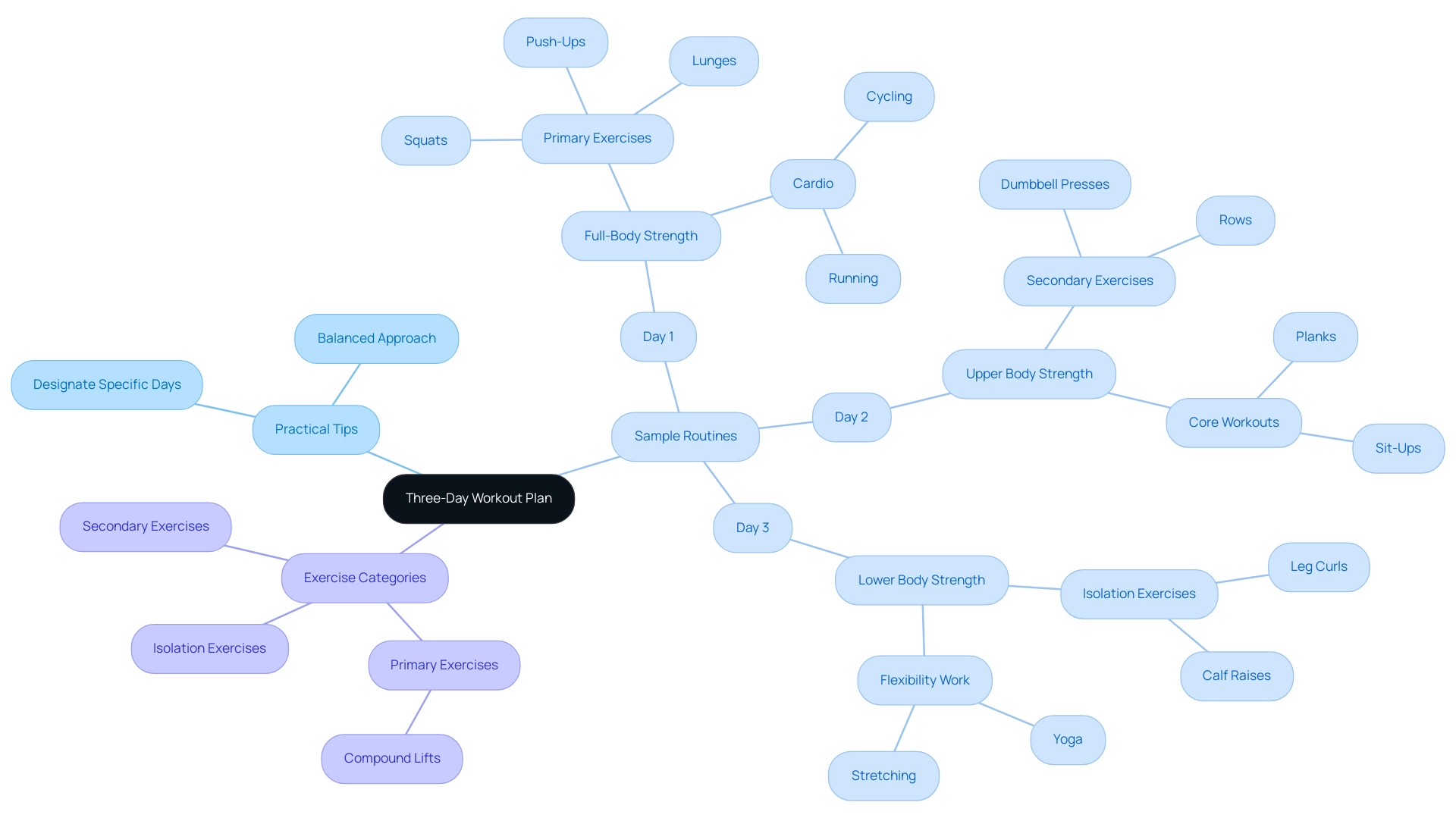
Conclusion
Embracing a three-day workout routine presents a transformative opportunity for busy professionals to enhance their health and well-being without overwhelming their schedules. By integrating cardiovascular exercise, strength training, and flexibility work, individuals can achieve significant fitness gains while benefiting from personalized coaching and a supportive community. Research underscores the effectiveness of structured exercise, highlighting improvements in strength, mental health, and even life expectancy.
This approach not only facilitates personal health but also fosters a culture of well-being within organizations. As teams engage in this manageable fitness strategy, they cultivate resilience and camaraderie, which can lead to reduced absenteeism and increased productivity. The flexibility of choosing between full-body or split routines allows individuals to tailor their workouts to their specific goals, ensuring that everyone can find a path that suits their lifestyle and preferences.
Ultimately, prioritizing a three-day workout plan is an investment in both individual and organizational health. By committing to this achievable regimen and harnessing the resources available through wellness coaching, teams can thrive in their fitness journeys, leading to a more engaged and healthier workforce. Now is the time to take action, inspire your teams, and create a lasting impact on their health and wellness journey.




